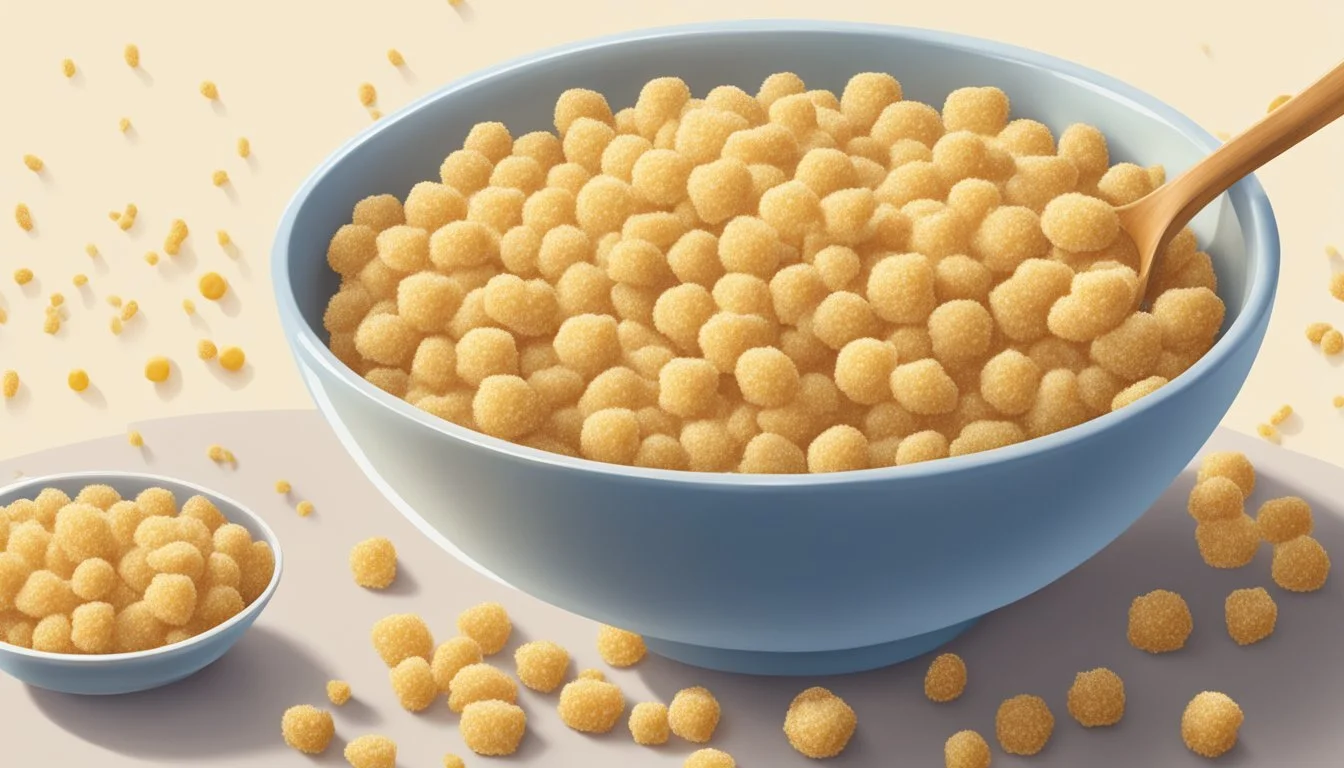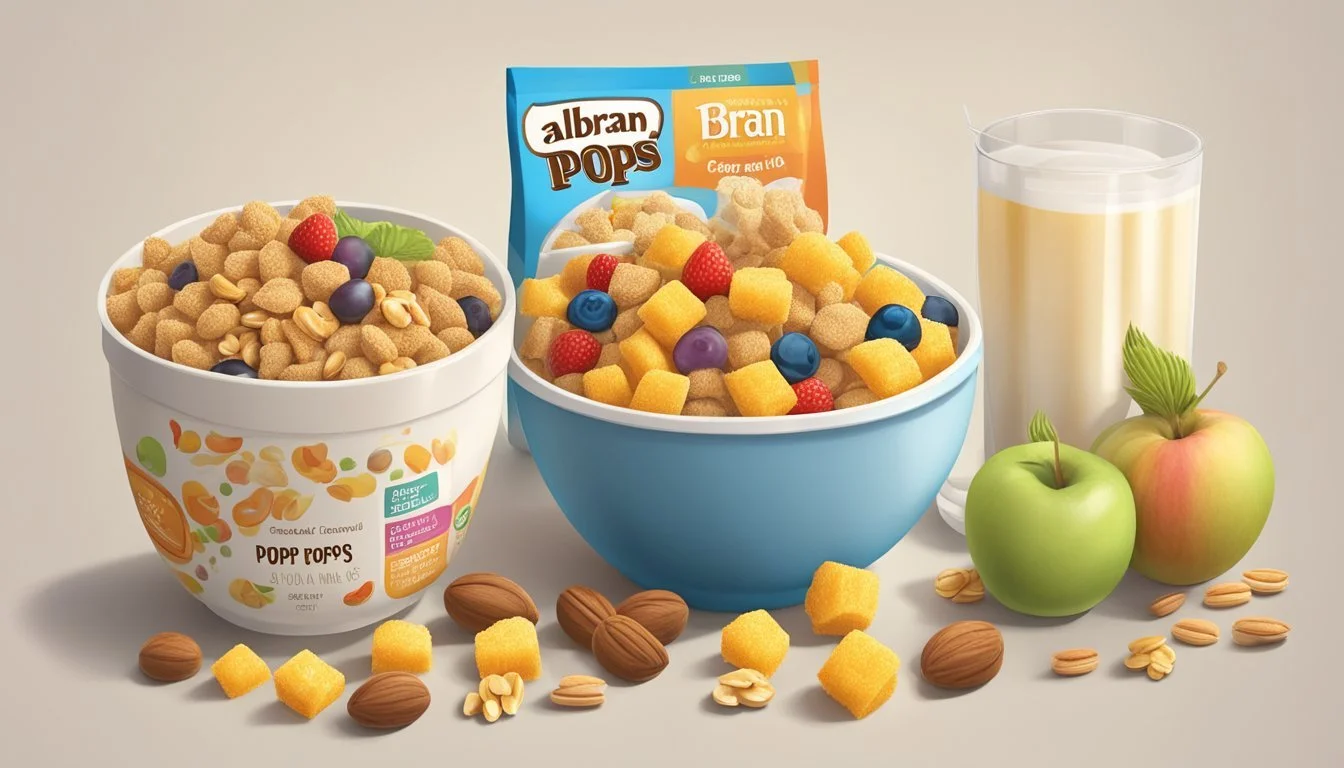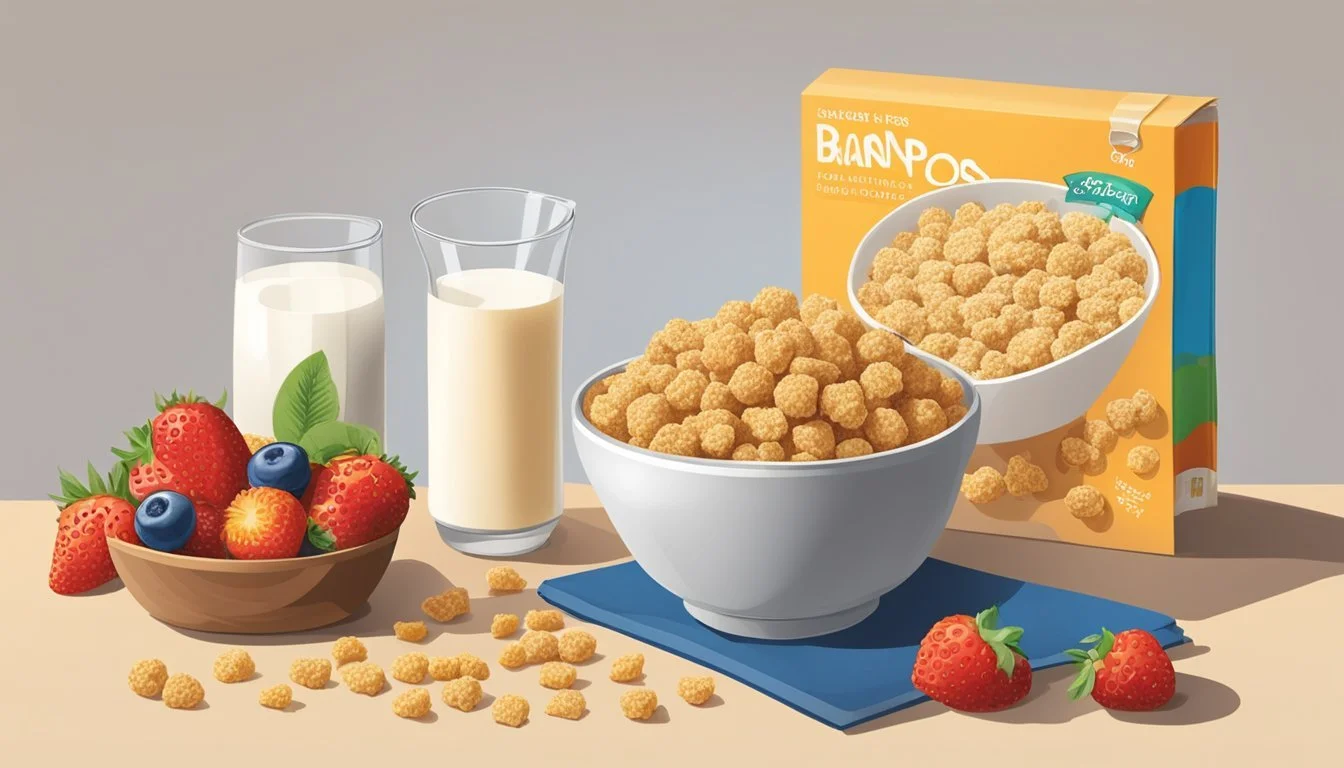All-Bran vs Corn Pops
Nutritional Comparison and Health Implications
This Article is Part of Our Breakfast Cereal Guide with Details on All-Bran Nutrition and Corn Pops Nutrition
Choosing the right breakfast cereal can be daunting, especially with so many options available. Two popular choices include All-Bran and Corn Pops, each offering unique nutritional profiles and flavors. When considering health benefits, All-Bran clearly stands out with its higher content of vitamins and minerals such as Vitamin B6, Vitamin B12, and dietary fiber.
While Corn Pops might appeal to those preferring a sweeter taste, it doesn't match the nutrient density of All-Bran. All-Bran boasts 7 grams of complex carbohydrates per serving, supporting sustained energy release throughout the morning. On the other hand, Corn Pops offer 13 grams of complex carbohydrates, which largely come from sugars, leading to quicker but less sustained energy.
For those mindful of their sugar intake and looking for a fiber-rich start to their day, All-Bran is the better option. It not only aids in digestion but also provides essential antioxidants, unlike the more sugar-laden Corn Pops. This distinction makes All-Bran an ideal choice for a nutrient-packed breakfast.
Historical Background
All-Bran and Corn Pops have distinct origins and evolution, reflecting their unique paths within the Kellogg's brand. The story of each cereal highlights their individual histories and how they've transformed over the years.
Origin of All-Bran
All-Bran was introduced in 1916 by Kellogg's. It followed the success of Kellogg's Bran Flakes, which had debuted the previous year. The cereal was initially marketed as a healthy option, rich in dietary fiber from wheat bran.
All-Bran's original ingredients have remained relatively consistent. The initial recipe included wheat bran, sugar, corn, barley malt extract, and salt. Its packaging, featuring a red and green box, was similar to other Kellogg’s cereals at the time. This simple yet effective composition positioned All-Bran as a staple in high-fiber diets.
Evolution of Corn Pops
Corn Pops, also a product of Kellogg's, had a slightly later introduction, debuting in 1950. Originally named "Corn Pops," they were soon renamed "Sugar Corn Pops" in 1951. This name changed several times, reflecting shifting consumer preferences around sugar content in breakfast cereals.
The cereal gained popularity through strategic advertising. Corn Pops became the sponsor of the radio and television show "The Adventures of Wild Bill Hickok," which significantly boosted their visibility. In 1984, the name reverted to "Corn Pops." Its formulation, a sweetened, puffed corn cereal, has remained beloved by children and adults alike, despite the numerous name changes.
Nutritional Profiles
The nutritional values of All-Bran and Corn Pops differ significantly in terms of fiber, vitamins, and sugar content. Below is a detailed comparison to help make an informed choice.
Macronutrients and Calories
All-Bran contains 70 calories per serving. It is low in fat with only 0.5 grams and provides 4 grams of protein. Carbohydrates make up the majority of this cereal, with 24 grams per serving. Corn Pops, in contrast, have a slightly higher calorie content at around 110 calories per serving. This cereal has 0 grams of fat, 1 gram of protein, and 25 grams of carbohydrates. The calorie difference mainly stems from varied serving sizes and ingredient compositions.
Vitamin and Mineral Content
All-Bran is fortified with various vitamins and minerals. It contains significant amounts of B-Vitamins like B1, B2, B6, and B12, which are essential for energy metabolism. It also supplies a good quantity of Iron, Calcium, and Vitamin D. Corn Pops also contain fortified vitamins and minerals but in lesser concentrations. Both cereals supply Vitamin C and Vitamin E, although All-Bran generally offers higher percentages in these areas.
Fiber and Sugar Analysis
Fiber content is a standout feature for All-Bran, providing approximately 10 grams per serving. This high fiber content aids in digestive health and helps maintain satiety. In contrast, Corn Pops only offer about 2 grams of fiber per serving. On the sugar front, Corn Pops contain significantly more sugar, typically around 9 grams per serving, compared to All-Bran’s lower sugar content of about 6 grams. This makes All-Bran a better option for those monitoring sugar intake.
Both cereals have their unique advantages; All-Bran shines in fiber and essential nutrients, whereas Corn Pops tend to be a sweeter, less nutrient-dense choice.
Health Implications
All-Bran and Corn Pops differ significantly in their nutritional profiles and associated health impacts. Both cereals offer distinct benefits and concerns, particularly related to fiber content, sugar levels, and overall diet suitability.
Benefits of High Fiber
All-Bran is rich in dietary fiber, which aids in digestive health. A serving of All-Bran provides a substantial percentage of the daily recommended fiber intake. This can improve bowel regularity and help prevent constipation.
Additionally, high-fiber foods like All-Bran may assist in weight management by promoting satiety. Fiber-rich diets have been linked to lower risks of heart disease and diabetes. All-Bran's high fiber content, from whole grains, can also lower cholesterol levels, offering a protective effect against cardiovascular diseases.
Effects of Sugars on Health
Corn Pops contain higher amounts of sugar compared to All-Bran. Elevated sugar intake is associated with several health issues. Frequent consumption of high-sugar foods can lead to weight gain, increasing the risk of obesity and related chronic diseases, such as type 2 diabetes.
High sugar content elevates the glycemic index of a diet, leading to rapid spikes and drops in blood sugar levels. This can cause energy fluctuations and affect mood. Eating moderate amounts of cereals like Corn Pops should be balanced with low-sugar foods to maintain overall health.
Considerations for Diet and Lifestyle
When choosing between All-Bran and Corn Pops, one's dietary goals and lifestyle are crucial factors. All-Bran is better suited for individuals focusing on weight loss and nutritional benefits tied to high fiber intake. It is also beneficial for those aiming to improve their cholesterol levels and enhance digestive health.
Corn Pops might appeal to those looking for a quick energy boost due to its higher sugar content. However, they should be consumed in moderation, especially by those managing their blood sugar levels or seeking a balanced diet. Saturated fat content should also be considered, although both cereals generally contain low levels.
Taste and Texture
When comparing All-Bran and Corn Pops, their taste and texture offer very distinct experiences to the consumer. Differences in ingredients and preparation influence these comparisons significantly.
Flavor Profiles
All-Bran Original has an earthy, somewhat neutral flavor with subtle sweetness. The dominant taste comes from wheat bran, providing a more natural and less processed flavor. Consumers often enhance its taste by adding fresh fruits or nuts, which also add nutritional benefits.
On the other hand, Corn Pops present a much sweeter profile due to high sugar content. Made predominantly of corn, Corn Pops have a distinct corn flavor that is more appealing to those who prefer a sugary, cereal experience. The sweetness can be balanced with milk, though some may still find it overpowering.
Texture Contrast Between All-Bran and Corn Pops
All-Bran Original is characteristically dense and somewhat gritty, providing a substantial chew. When combined with milk, it softens but retains a firm bite, ensuring a consistent texture that appeals to those seeking a hearty breakfast.
Corn Pops, conversely, are light and airy. They offer a pleasing crunch that can quickly turn soggy when immersed in milk. This contrasts starkly with All-Bran's firmness and can be seen as more of a treat than a substantial meal.
The textures cater to different preferences: All-Bran suits those who enjoy a robust, fiber-rich start to their day, while Corn Pops entice those who favor a lighter, sweeter morning delight.
Consumer Information
The consumer information about All-Bran and Corn Pops covers essential aspects like packaging, pricing, and serving recommendations. This will help in understanding the value and nutritional content of each cereal.
Packaging and Pricing
All-Bran:
All-Bran typically comes in a cardboard box with a plastic inner lining. The packaging is designed to maintain freshness and preserve the cereal's high-fiber content.
Prices for All-Bran generally vary between $4 to $5 for a 500g box, which offers around 10 servings.
Corn Pops:
Corn Pops also come in a standard cardboard box with a plastic inner lining. The design aims to keep the cereal crunchy and flavorful.
Corn Pops are generally a bit cheaper, ranging from $3 to $4 for a 400g box, providing about 9 servings.
Consumers should check local stores or online retailers for the latest prices, as they can fluctuate.
Serving Recommendations
All-Bran:
A single serving size of All-Bran is usually around 40 grams. Each serving provides approximately:
Calories: 80
Protein: 3 grams
Dietary Fiber: 10 grams
All-Bran is ideal for those aiming to increase their daily fiber intake. It's recommended to mix it with milk, yogurt, or even smoothies.
Corn Pops:
A typical serving size for Corn Pops is about 30 grams. This serving provides:
Calories: 120
Protein: 1 gram
Dietary Fiber: 1 gram
Corn Pops are more suited for those who prefer a sweeter, crunchy breakfast. They can be eaten with milk or as a dry snack.
Both cereals have their own nutritional benefits, catering to different dietary needs and preferences.
Culinary Uses and Recipes
Both All-Bran and Corn Pops offer distinct culinary benefits. All-Bran is excellent for baking and adding a nutritious twist to various dishes, while Corn Pops serve as a versatile snack and ingredient in creative recipes.
All-Bran in Baking and Cooking
All-Bran can enhance the nutritional value of baked goods and dishes. It integrates seamlessly into muffins, bread, and pancakes. Adding All-Bran to these foods boosts fiber and nutrient content without compromising taste.
You can also use All-Bran as a base for granola or in yogurt parfaits. By combining it with dried fruit, nuts, and honey, you can create homemade cereal bars. These bars provide a quick, nutritious snack for busy lifestyles.
Integrating All-Bran into meatloaf or meatballs can improve their texture and fiber content. It absorbs moisture, making it an ideal binding agent. This cereal offers versatility for food enthusiasts who want to experiment with healthier versions of classic recipes.
Corn Pops as a Snack and in Recipes
Corn Pops work well as a standalone snack. They provide a sweet, crunchy bite that's perfect for on-the-go munching. Kids and adults alike enjoy (Corn Pops' light, sweet flavor).
For a creative twist, use Corn Pops in dessert recipes. They add crunch to chocolate bark, cookies, and even ice cream toppings. Mixing them with marshmallows creates a quick, no-bake treat similar to rice crispy squares.
Incorporating Corn Pops into trail mix with dried fruit and nuts offers a sweet and savory snack option. This combination is ideal for hiking, road trips, or as a simple, homemade snack to keep on hand.
Corn Pops can also be a fun garnish for soft foods like yogurt or pudding, adding a crunchy texture contrast.
Dietary Considerations
When evaluating All-Bran versus Corn Pops, it is essential to consider their suitability for specialized diets and their overall health benefits. Each cereal offers varied nutritional profiles that can align differently with individual dietary needs.
Meeting Specialized Dietary Restrictions
All-Bran is a rich source of dietary fiber, boasting around 9 grams per serving. However, it is not gluten-free, making it unsuitable for those with celiac disease or gluten sensitivities.
Corn Pops, on the other hand, generally contain lower fiber but are a gluten-free option, which could appeal to those avoiding gluten.
For vegans, both cereals can be suitable if no animal-derived additives are present, although it's essential to check specific product formulations as ingredients can change.
When it comes to allergies, All-Bran may include ingredients like wheat, posing a risk for wheat allergies, whereas Corn Pops may have less common allergenic components but still require caution for corn allergies.
Comparative Healthiness
All-Bran is often considered the healthier choice due to its high fiber content, which promotes digestive health. It has about 9 grams of fiber per serving compared to Corn Pops' 1 gram. Additionally, All-Bran has lower sugar content, with around 5 grams per serving, making it a better option for those monitoring sugar intake.
Corn Pops contain roughly 12 grams of sugar per serving, which might be less optimal for those seeking to reduce sugar consumption. Despite their lower fiber content, their gluten-free nature can make them more appealing depending on individual dietary needs.
Nutritionally, All-Bran's higher manganese content and other vitamins and minerals might benefit overall health more compared to Corn Pops, which offers fewer essential nutrients.
Market Analysis
This section provides an in-depth look at the influence of brand reputation on consumer choice as well as current trends in the health-focused breakfast cereal market. Both All-Bran and Corn Pops need to be examined in the wider market context.
Brand Influence in Consumer Choice
Brand reputation plays a crucial role in shaping consumer preferences. Kellogg's, the parent company of both All-Bran and Corn Pops, holds a strong position in the cereal market with significant brand recognition.
Consumers often rely on familiar brands when making purchasing decisions. Kellogg's market capitalization as of August 2023 was $21.17 billion.
All-Bran targets health-conscious consumers, bolstered by its high fiber content. Corn Pops, on the other hand, appeals mainly to younger demographics with its sweeter taste.
The strength of Kellogg's brand helps both cereals maintain stable sales volumes despite different target markets. Brand loyalty is evident, especially among long-term customers.
Trends in Healthy Breakfast Options
Market trends indicate a growing consumer interest in healthier breakfast options. There's a noticeable shift toward cereals with higher nutritional value and fewer artificial ingredients.
All-Bran benefits from this trend due to its high fiber and low sugar content. The data shows it contains 7.0 grams of complex carbohydrates per serving.
In contrast, Corn Pops has a higher sugar content but 13.0 grams of complex carbohydrates, appealing to those prioritizing energy-boosting carbs.
Health awareness drives many consumers toward All-Bran, as demonstrated by increasing sales of high-fiber products. The move towards clean labels and organic ingredients is reshaping the cereal market.
Manufacturers are adapting to these changes, modifying their product lines to align with consumer preferences for healthier options.








